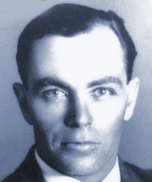Herbert J. L. Hinkler
Today, an odd hero of early aviation. The University of Houston's College of Engineering presents this series about the machines that make our civilization run, and the people whose ingenuity created them.
 Bert Hinkler was the first Australian aviator to gain international prominence. Born in 1892 in the East-Coast town of Bundaberg, he fixated on flying from the start. When he was fourteen he tried to make an ornithopter -- an airplane with flapping wings. It failed, but in 1911 he made a successful glider. Then an American barnstormer, Wizard Stone, showed up in Australia with his Bleriot airplane. Hinkler became his mechanic and apprentice.
Bert Hinkler was the first Australian aviator to gain international prominence. Born in 1892 in the East-Coast town of Bundaberg, he fixated on flying from the start. When he was fourteen he tried to make an ornithopter -- an airplane with flapping wings. It failed, but in 1911 he made a successful glider. Then an American barnstormer, Wizard Stone, showed up in Australia with his Bleriot airplane. Hinkler became his mechanic and apprentice.
In 1914 Hinkler went to England to work in the Sopwith Company. During WW-I he flew bombers. He had little stomach for bombing and strafing retreating troops. Still, he shot down six planes and won medals. He also married a nurse he'd met in France.
Next, he turned to long-distance flying. His five-foot-four frame gave him an edge in a cramped cockpit. He dreamt of flying home to Australia. He was turned back at Rome when he started the flight in 1920. A war had broken out around his next fuel stop in Syria. Still, he did win a trophy for his flight across Europe. He set other distance records. He also served as a test pilot for the radical new wingless forerunner of the helicopter -- the autogyro.
Hinkler finally made the first solo flight to Australia in 1928. It took fifteen days and, once there, he enjoyed his greatest hour of glory -- parades, speeches, and a popular song that began, Hustling Hinkler, up in the sky ...
Back in England, he tried to set up an airplane company, but the depression killed it. He moved to Canada to see what his prospects might be for building airplanes there. But he was soon back to setting distance records. And darker overtones begin to color Bert Hinkler's driven life. In 1932, he married again. This time his wife was an American woman whom he'd known for some time.
Was he divorced by then? His biographies conflict. One mentions one wife, one mentions the other. A TV documentary suggests bigamy. That year he went back to Europe. His American wife made her home in Paris. Then, in January, 1933, he set out on a flight all the way from England to Canada by way of Australia.
But he vanished over Italy's Apennine mountains. Three months later a charcoal gatherer found his crashed plane with his frozen body nearby. The investigation showed he'd thrown a propeller blade. It also suggested sabotage. Then we learn that his home was rifled a week before the flight -- documents stolen and all the pictures of his mother smashed. Was there a conspiracy here? Did it involve a wife or an angry colleague? We're left to wonder.
Bert Hinkler's story may leave us unsatisfied, but it nevertheless reveals the raw, driving compulsion that brought flight into being. Hinkler didn't do so well with the parts of his life outside the hangar and the cockpit. But in the cockpit he was clearly one of the many driven geniuses who really did shape our reality of flight -- from the stuff of his own childhood dreams.
I'm John Lienhard, at the University of Houston, where we're interested in the way inventive minds work.
(Theme music)
Wixted, E. P., Hinkler, Herbert John Louis. Australian Dictionary of Biography (gen'l. eds. Bede Nairn and Goeffrey Serle). Melbourne: Melbourne University Press, 1981.
Anon, Hinkler, Herbert, John Louis. The Australian Encyclopaedia (editor-in-chief Alec H. Chisholm). Sydney: Halstead Press, 1958.
For more on Hinkler see the Wikipedia article on Bert Hinkler.
This is a greatly revised version of Episode 172.